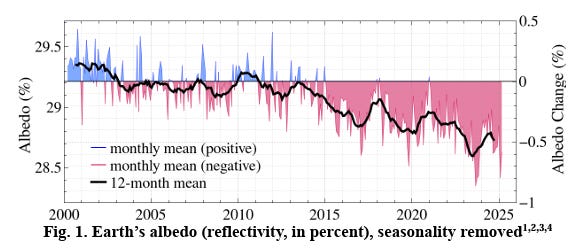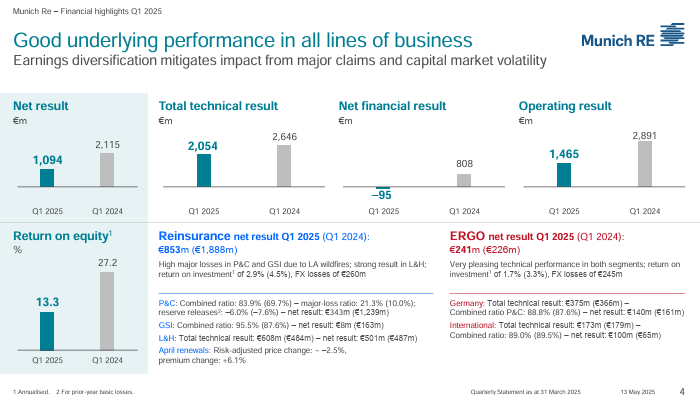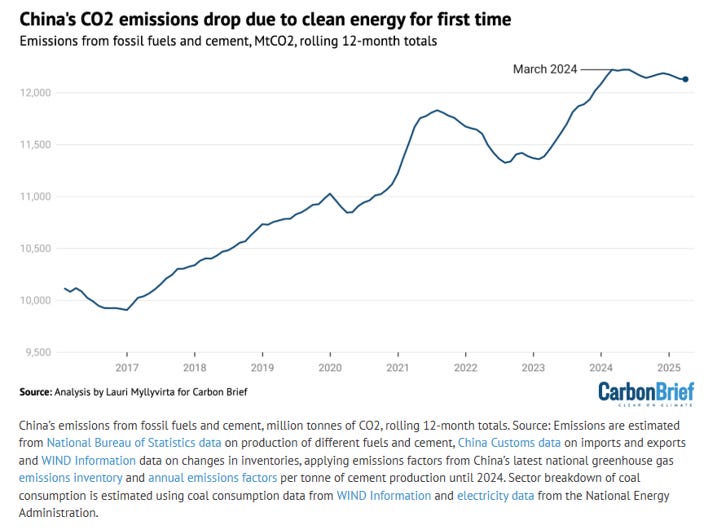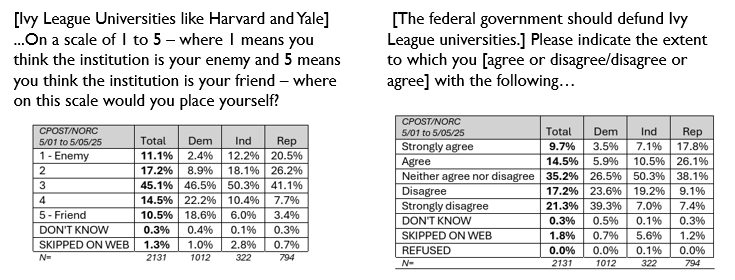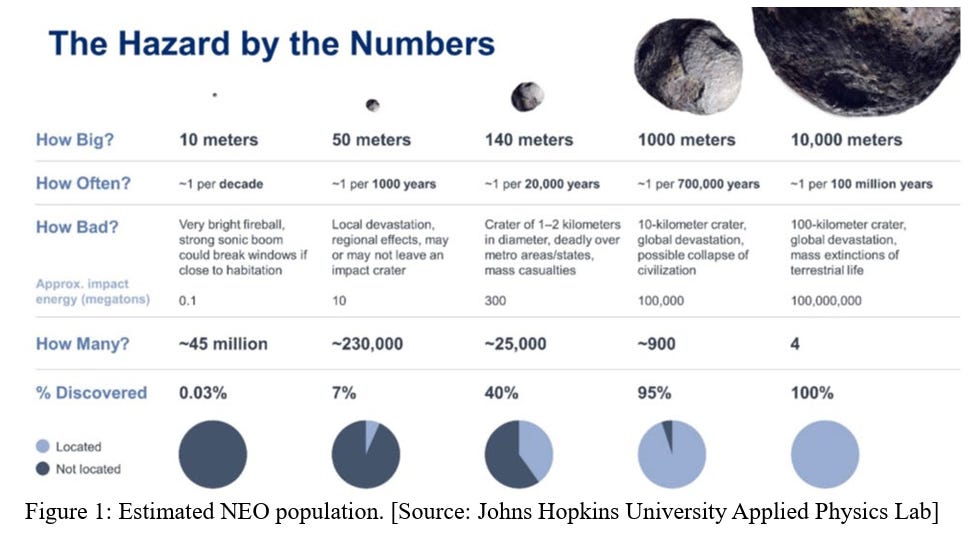|
The figures and data below are all hot of the press and shared to help get your weekend off to an intellectually stimulating start. Enjoy!
The Earth is Darkening
In a new posting, climate scientist James Hansen calls our attention to a “BFD”:
Earth’s albedo (or reflectivity) is the portion (percent) of incoming solar radiation that is reflected back to space. As shown in Fig. 1, in the period of precise satellite data (since early 2000), Earth’s albedo has decreased about 0.5%. We described this change as a BFD because it has staggering implications. Solar radiation reaching Earth is about 340 W/m^2, averaged over Earth’s surface, so the 0.5% albedo decrease is a 1.7 W/m increase of absorbed solar energy . . . A 1.7 W/m^2 increase of absorbed solar energy is huge. If it were a climate forcing, it would be equivalent to a CO2 increase of 138 ppm . . .
Hansen hypothesizes that the albedo change is due to the effects of increasing greenhouse gases on clouds. Others have recently documented a decrease in the Earth’s albedo, but are less certain than Hansen on its causes and consequences, but agrees that Hansen’s hypothesis is plausible:
Three fundamental mechanisms may have contributed to the record-low planetary albedo associated with reduced low-level clouds: internal variability, an emerging low-cloud feedback, and aerosol effects. Contributions from internal variability would subside and leave our expectation of the longer-term warming unaffected. . . if the cloud-related albedo decline was caused not solely by internal variability, the 2023 extra heat may be here to stay and Earth’s climate sensitivity may be closer to the upper range of current estimates. We may thus be closer to the temperature targets defined in the Paris agreement than previously thought . . .
Hansen also complains about a “clique” of climate scientists controling narratives, calling his views “fringe.” Hansen complains that “criticisms were largely ad hoc opinions, even ad hominem attacks. How can science reporting have descended to this level?” Some of us have been asking this for a while.
Swiss Re on Why Disaster Losses are Increasing
 |
Swiss Re, one of the world’s biggest reinsurance companies, sees expected insured catastrophe losses increasing at a rate of 5-7% per year, and overall economic losses increasing at 3-4% per year., explaining:
Losses are primarily driven by socioeconomic factors. The main driver keeping insured losses on a steep upward trajectory is rising exposure values as a result of economic growth and expanding populations, often in regions susceptible to severe weather conditions. Urbanisation is leading to denser urban areas and higher concentration of more valuable assets at risk that need insuring. At the same time, inflation pressure, including in construction costs, is driving exposure values even higher and makes rebuild more expensive. In addition, observed climate change effects are also playing a role in compounding losses for some perils and regions.
For 2025, Swiss Re sees a ~10% chance of insured global economic losses from disasters exceeding $300 billion. The figure below shows both insured (dark part of bars) and total economic losses from disasters.
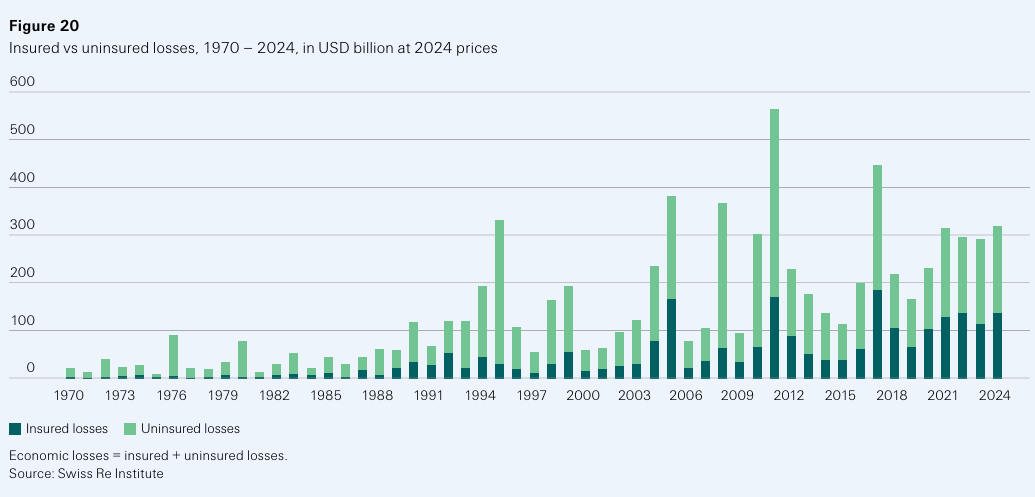 |
Disasters are Good for Business
Munich Re, the other big global reinsurer, released its 1Q 2025 financial results, showing a big hit from the California fires, totalling 800 million Euros to date, with an expectation that total claims will be 1.1 billion Euros. Even so:
Outlook for 2025: Annual guidance unchanged at €6bn
Anticipating sustained advantageous business opportunities in coming quarters, Munich Re is aiming to generate a net result of €6.0bn for the 2025 financial year. The targets communicated for 2025 in Munich Re’s Group Annual Report 2024 remain unchanged.
Reinsurance is good business, backed by a sophisticated understanding of risk.
Peak Carbon Dioxide in China?
Over the past year, China’s carbon dioxide emissions (from fossil fuels and cement) declined, according to Carbon Brief, which attributes the decline to reduced fossil fuel consumption made possible by the deployment of carbon-free alternatives. Carbon Brief concludes:
The past 12 months mark a potentially significant turning point for China’s CO2 emissions, with clean-energy growth for the first time outpacing demand growth and displacing fossil fuel use in the power sector.
Record-breaking clean energy additions expected in 2025, despite new pricing policy uncertainties, suggest that the trend will continue this year.
The longer-term trajectory depends heavily on the targets set in the upcoming five-year plan and on the economic policy response to US tariffs and other economic headwinds. . .
[T]here is potential for China’s emissions to continue to fall and for the country to achieve substantial absolute emissions reductions over the next five years.
However, policy choices working in the opposite direction could just as easily see emissions increase further towards 2030.
Some caveats: China’s official data may not be reliable. Carbon Brief’s suggestion that the downturn is not due to economic factors might not be correct. If the downturn is real a persists it would be a massive development.
A Slowdown in Growth in Global Oil Consumption
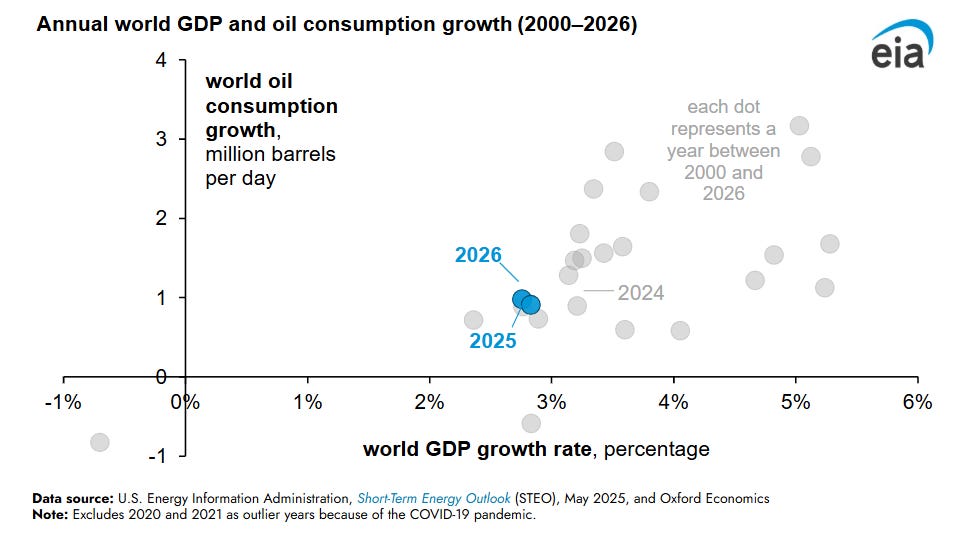 |
The U.S. Energy Information Agency forecasts a slowdown of the increase in global oil consumption:
We forecast consumption growth of crude oil and other liquid fuels will slow over the next two years, driven by a slowdown in economic growth, particularly in Asia, in our May Short-Term Energy Outlook (STEO).
The world economy, measured by GDP, increases 2.8% in 2025 and 2026 in our forecast. Excluding the years of global economic contraction in 2020 and 2009, these economic growth rates would be the lowest since 2008. Considerable uncertainty over world trade, manufacturing, and investment points to downside risk in economic growth, which has a direct effect on oil consumption.
Economic activity uses energy. Increases in population, individual mobility, the shipping of goods, and industrial output result in more oil consumption. Since the year 2000, annual oil consumption growth has been the lowest during the years when the world economy grew by less than 3%. World oil consumption was around 103 million barrels per day (b/d) last year based on preliminary estimates.
This projection, coupled with the plateauing of China’s cabon dioxide emissions suggest that the long-plateu in global carbon dioxide emissions is set to continue, with per CO2 emissions perhaps opossible by 2030. But as EIA warns: “Our forecast remains highly uncertain and subject to change.” Caveat lector!
Federal Budget Math
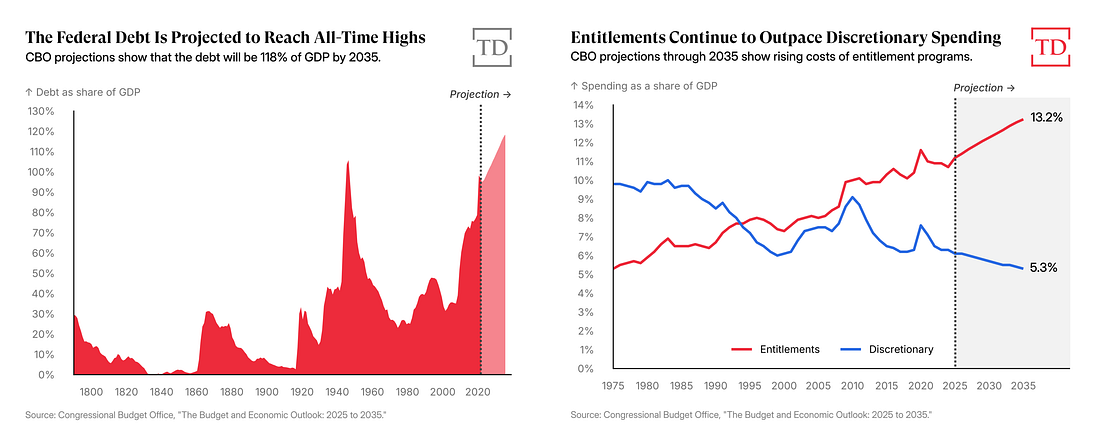 |
If reducing the growth in the federal debt (left panel above) is a good idea — and I think it is — then the simple math of the federal budget tells us what needs to happen: revenue needs to increase and entitlements (like Social Security and Medicare, red line in the right panel above) need to be reined in. Yuval Levin explains:
[A]ll domestic discretionary spending is now about 14 percent of the federal budget, while entitlement spending amounts to more than 50 percent, according to CBO figures. More importantly, the growth in federal spending is heavily concentrated in entitlement spending, while discretionary spending is declining as a share of the budget and the economy.
It simply isn’t possible to offset the coming growth of Social Security and Medicare spending by curbing domestic discretionary spending. . .
This means that any effort to seriously improve the fiscal trajectory of the federal government has to be focused on entitlement reform. There is no alternative.
Levin argues that Republicans today (i.e., the “one big beautiful bill”) are making things worse and have a “debt delusion.”
A Scapel not a Sledgehammer
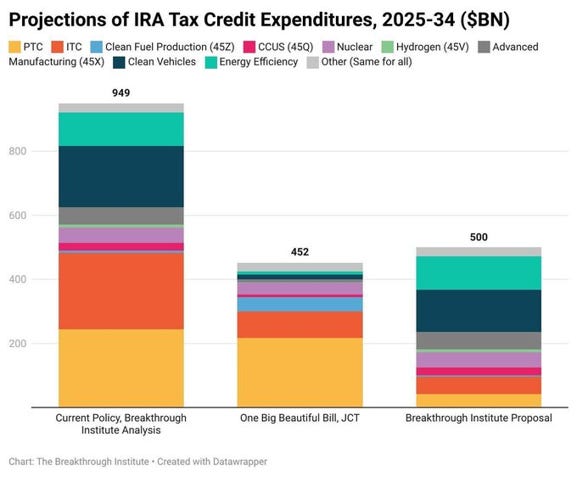 |
The Breakthrough Institute has proposed how to reform the Inflation Reduction Act in ways that keep its most valuable provisions in support of energy innovation and discards those that make less sense, like subsidies for mature, cost-competitive technologies. BTI argues:
This sledgehammer approach to IRA reform would be a significant overcorrection by Republicans. According to Breakthrough’s analysis, more strategic cuts to the tax credits, targeting only the most mature energy industries subsidized under the IRA, could achieve the bulk of the budgetary savings the Big Beautiful Bill would, without kneecapping emerging industries like nuclear, geothermal, and critical minerals. Our updated calculations reaffirm that our proposal would yield on the order of $449 billion in fiscal savings, compared to the JCT’s new estimate of $496B in savings from the Big Beautiful Bill.
Universities: Friends or Enemies?
The University of Chicago this week release an opinion poll of how Americans view universities. One question asked respondents if they viewed Ivy League universities as a “friend” or “enemy” (left table above), and another about defunding these campuses by the federal government (right table above).
The partisan split is impossible to ignore. My view is that much of the action being taken by the Trump Administration against universities, and science institutions more generally, reflects a vengence agenda. There is a lot wrong with universities (trust me on that), but an own-the-libs approach to reform will have a baby-and-bathwater problem. Expect a full post on this in the coming weeks.
Don’t Look Up
Yesterday, the House Science Committee held a hearing on the threat posed by asteroid impacts and how we might prepare to mitigate that threat. Did you know that the U.S. government has a planetary defense strategy? That strategy characterizes what is known about the risks:
Up to 1,000 NEOs greater than 1 kilometer in size that are potentially capable of causing global impact effects. Approximately 95 percent of these bodies have been found and none are a current threat for impact.
Over 230,000 objects likely exist that are 50 meters or larger in size and could destroy a concentrated urban area. It is estimated that fewer than eight percent of these have been detected.
Tens of millions of smaller NEOs exist. While most are small enough to likely break up in Earth’s atmosphere during an impact, those larger than 10 meters in size could potentially cause some surface damage. It is estimated that less than one percent of these small bodies have been discovered.
Planetary defense is surely one area of science and technology for which most everyone would support federal funding and coordination of response — unlike other topics that today have become unnecessarily pathologically politicized.
Comments on any of the above are welcomed. Have a great weekend!
The easiest thing you can do to support THB is to click that “♡ Like”. More likes mean that THB gets in front of more readers!
Reminder — If you are looking for a fantastic speaker at your event, hit me up.
This post has been brought to you by the paid subscribers of THB, whose support makes THB possible. If you value THB and the work it brings several times per week to your inbox and the public, please consider joining the paid subscribers as a THB supporter. I am appreciative — Thank you!
You're currently a free subscriber to The Honest Broker. For the full experience, upgrade your subscription.

